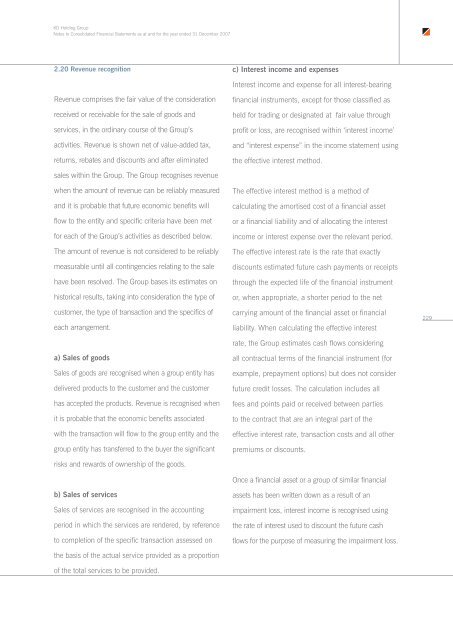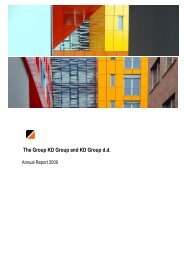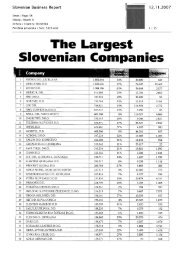We build business networks and relationships ... - skupina kd group
We build business networks and relationships ... - skupina kd group
We build business networks and relationships ... - skupina kd group
Create successful ePaper yourself
Turn your PDF publications into a flip-book with our unique Google optimized e-Paper software.
KD Holding Group<br />
Notes to Consolidated Financial Statements as at <strong>and</strong> for the year ended 31 December 2007<br />
2.20 Revenue recognition<br />
c) Interest income <strong>and</strong> expenses<br />
Interest income <strong>and</strong> expense for all interest-bearing<br />
Revenue comprises the fair value of the consideration<br />
received or receivable for the sale of goods <strong>and</strong><br />
services, in the ordinary course of the Group’s<br />
activities. Revenue is shown net of value-added tax,<br />
returns, rebates <strong>and</strong> discounts <strong>and</strong> after eliminated<br />
sales within the Group. The Group recognises revenue<br />
when the amount of revenue can be reliably measured<br />
<strong>and</strong> it is probable that future economic benefits will<br />
flow to the entity <strong>and</strong> specific criteria have been met<br />
for each of the Group’s activities as described below.<br />
The amount of revenue is not considered to be reliably<br />
measurable until all contingencies relating to the sale<br />
have been resolved. The Group bases its estimates on<br />
historical results, taking into consideration the type of<br />
customer, the type of transaction <strong>and</strong> the specifics of<br />
each arrangement.<br />
a) Sales of goods<br />
Sales of goods are recognised when a <strong>group</strong> entity has<br />
delivered products to the customer <strong>and</strong> the customer<br />
has accepted the products. Revenue is recognised when<br />
it is probable that the economic benefits associated<br />
with the transaction will flow to the <strong>group</strong> entity <strong>and</strong> the<br />
<strong>group</strong> entity has transferred to the buyer the significant<br />
risks <strong>and</strong> rewards of ownership of the goods.<br />
b) Sales of services<br />
Sales of services are recognised in the accounting<br />
period in which the services are rendered, by reference<br />
to completion of the specific transaction assessed on<br />
the basis of the actual service provided as a proportion<br />
of the total services to be provided.<br />
financial instruments, except for those classified as<br />
held for trading or designated at fair value through<br />
profit or loss, are recognised within ‘interest income’<br />
<strong>and</strong> “interest expense” in the income statement using<br />
the effective interest method.<br />
The effective interest method is a method of<br />
calculating the amortised cost of a financial asset<br />
or a financial liability <strong>and</strong> of allocating the interest<br />
income or interest expense over the relevant period.<br />
The effective interest rate is the rate that exactly<br />
discounts estimated future cash payments or receipts<br />
through the expected life of the financial instrument<br />
or, when appropriate, a shorter period to the net<br />
carrying amount of the financial asset or financial<br />
liability. When calculating the effective interest<br />
rate, the Group estimates cash flows considering<br />
all contractual terms of the financial instrument (for<br />
example, prepayment options) but does not consider<br />
future credit losses. The calculation includes all<br />
fees <strong>and</strong> points paid or received between parties<br />
to the contract that are an integral part of the<br />
effective interest rate, transaction costs <strong>and</strong> all other<br />
premiums or discounts.<br />
Once a financial asset or a <strong>group</strong> of similar financial<br />
assets has been written down as a result of an<br />
impairment loss, interest income is recognised using<br />
the rate of interest used to discount the future cash<br />
flows for the purpose of measuring the impairment loss.<br />
229







